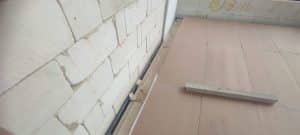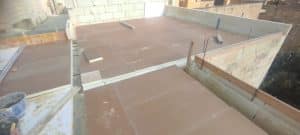Let’s face it—renovations in Malta can get expensive fast. Between materials, labour, and time, most people assume a stylish, modern surface like microcement must be pricey. But here’s the twist: it’s not. In fact, the cost of microcement starts at just €65 per square metre or more, depending on your project specifics. So, when people ask: Is microcement expensive?—the answer is a confident no, especially when you consider what you’re getting.
Microcement isn’t just about style; it’s about durability, flexibility, and low maintenance—all packed into one sleek finish. Whether you’re remodeling your bathroom, kitchen, or commercial space, microcement delivers a clean, modern aesthetic without draining your budget.
Let’s break it down, debunk the myths, and show you exactly why microcement is a smart, affordable choice for anyone building or renovating in Malta.
1. What Is Microcement and Why Is Everyone Talking About It?| Is Microcement Expensive
Microcement is a decorative, cement-based coating applied in thin layers (usually 2–3mm) to surfaces like floors, walls, stairs, and even furniture. Despite being thin, it’s incredibly strong and waterproof once sealed. This makes it perfect for bathrooms, kitchens, terraces, pools, and retail or hospitality spaces.
So, why the buzz? It’s not just a trend—it’s a transformation. With microcement, you can skip the demolition phase entirely. It adheres to existing tiles, plaster, wood, concrete—you name it. That means less mess, less labour, and less cost.
If you’re asking, “Is microcement expensive?”, you need to factor in what it saves you: time, material waste, and additional labour. That’s a serious win.
2. Breaking Down the Cost: Is Microcement Expensive Compared to Other Materials?| Is Microcement Expensive
Let’s talk numbers. The cost of microcement in Malta typically starts at around €65 per square metre. This includes materials and basic installation by a professional. Prices can rise to around €100–€130 per square metre depending on the complexity of the job, surface preparation, and design details.
Here’s how it compares with other common finishes:
| Material | Average Price per m² (Malta) | Requires Demolition | Maintenance | Durability |
|---|---|---|---|---|
| Microcement | €65–€130 | No | Very Low | High |
| Ceramic Tiles | €45–€120 | Often Yes | Medium | Medium |
| Natural Stone | €90–€180+ | Yes | High | High |
| Polished Concrete | €80–€140 | Sometimes | Low | High |
| Laminate Flooring | €30–€80 | Yes | Medium | Low |
At first glance, some materials may appear cheaper. But once you add the hidden costs—removal, disposal, adhesives, grout, and extended labour—microcement often works out to be far more cost-effective.
3. Hidden Value: Why Microcement Offers More Bang for Your Euro| Is Microcement Expensive
Sure, you’re not just paying for cement. You’re investing in a full-service finish that includes:
Custom colour blending to match your space
Seamless installation (no joints or grout lines)
Waterproof and anti-slip coatings
Long-lasting surface durability
Ultra-modern look that never goes out of style
It’s this all-in-one performance that makes microcement a high-value choice for homeowners and commercial clients alike.
For example, in high-humidity environments like Malta, microcement shines. It’s mould-resistant, quick-drying, and doesn’t warp or rot like wood or laminate might. Plus, cleaning is a breeze—no grout lines to scrub or worry about. Just a mop and a mild detergent will keep it looking fresh for years.
So, again we ask: Is microcement expensive? When you factor in how much it saves you in long-term maintenance and replacement—it’s actually a bargain.
4. The Installation Factor: Fast, Clean, and Minimal Disruption| Is Microcement Expensive
One major reason microcement is so cost-effective is how it’s installed. Unlike traditional flooring or tiling, there’s no need to rip up what’s already there. The microcement is applied directly over your existing surface, which drastically reduces labour time and cost.
Here’s how the installation process generally goes:
Surface Preparation – Existing surface is cleaned and lightly abraded.
Base Layer Application – Primer and base cement coats are added for strength.
Colour Layer – Your chosen colour blend is applied in micro-thin layers.
Sealing – A topcoat is added for waterproofing and durability.
Most residential jobs (bathrooms, kitchens, etc.) can be completed in 3–5 days depending on size. Compare that to the 1–2 weeks for tile removal, surface prep, installation, and grout setting.
Less mess. Less time. Less money. No wonder more people are asking about microcement—and loving the answer to is microcement expensive?
5. Microcement in Malta: Stylish Solutions for a Mediterranean Climate| Is Microcement Expensive
Let’s zoom in on Malta. With its hot summers, humidity, and salty air, choosing building materials that withstand the environment is essential. Microcement isn’t just suitable—it thrives in Mediterranean climates.
Why?
Heat Resistance: Microcement doesn’t expand or crack easily in warm temperatures.
Humidity-Proof: Sealed microcement resists mould, mildew, and moisture damage.
Aesthetic Match: It blends beautifully with Maltese interiors—whether it’s limestone walls, coastal tones, or contemporary minimalism.
It’s also ideal for renovations, a growing trend across the islands as more homeowners and business owners modernise older properties without gutting them. And with the high cost of full remodels in Malta, using microcement to refresh floors and walls is a strategic and affordable choice.
Bonus Insight: Microcement and Modern Construction Trends| Is Microcement Expensive
Globally, we’re seeing a shift toward minimalist, industrial-inspired finishes—and microcement fits perfectly within that design trend. Architects and designers love it for its flexibility and adaptability across different styles, from rustic to ultra-modern.
In fact, microcement is becoming a go-to material in green building and sustainable construction. Why? Because it reduces waste by eliminating the need for tear-outs, uses fewer raw materials, and has a long lifespan. You can read more about sustainability in construction to understand why materials like microcement are gaining attention in forward-thinking projects.
In Malta, where traditional aesthetics meet modern functionality, microcement bridges the gap—bringing innovation into heritage buildings, boutique hotels, retail stores, and family homes.
Want to Know More or Get a Quote?
At this point, if you’re still wondering, is microcement expensive?, let’s make it simple: not when you choose the right provider.
At Kibitec, we don’t just supply high-quality microcement in Malta—we apply it, design with it, and guide you through the process. Whether you’re refreshing your home, upgrading your business, or building from scratch, our expert team is here to help.
👉 Contact us today to get a free consultation or quote tailored to your project.
Real-Life Examples: Microcement Projects in Malta That Didn’t Break the Bank
Let’s look at how microcement is being used around Malta in beautiful, cost-conscious ways.
✨ Example 1: A Sleek Bathroom Renovation in Sliema
One homeowner in Sliema wanted to refresh their outdated tile bathroom into a spa-like sanctuary. Removing and replacing tiles would have taken over a week and cost them €3,000–€4,000. Instead, they opted for microcement on the floor and walls. The entire job took 4 days, cost around €1,800, and gave them a completely modern, waterproof finish without any demolition.
✨ Example 2: Microcement Floors in a Valletta Café
A café owner in Valletta wanted something modern, easy to clean, and stylish for their busy floors. Microcement was chosen over ceramic tiles for its seamless surface and minimal maintenance. Despite covering over 80 square metres, the project came in at under €6,000, including anti-slip coating—well within budget, and the café only had to close for three days during installation.
These are just a couple of examples, but they show how asking “Is microcement expensive?” might actually lead you to a smart, budget-friendly renovation solution—especially in high-traffic or moisture-prone areas.
Frequently Asked Questions About Microcement in Malta
To help you feel more confident about whether microcement is right for your space, here are some commonly asked questions we hear from our Maltese clients:
❓ How long does microcement last?
When properly installed and sealed, microcement can last over 15 years with minimal maintenance. It’s resistant to scratches, water, and heavy foot traffic, making it suitable for both residential and commercial spaces.
❓ Is it slippery when wet?
Not inherently. A non-slip additive can be included in the final sealing coat, making it safe for wet areas like bathrooms, showers, and pool decks.
❓ Can I use it outdoors?
Yes, microcement is suitable for outdoor use as long as it’s applied correctly with UV-resistant and waterproof sealers. It’s great for terraces, façades, and walkways, especially in Malta’s dry, sunny climate.
❓ What kind of maintenance is needed?
Very little! Just sweep and mop with a mild, non-acidic cleaner. No need to reseal regularly like natural stone or polish like marble.
❓ Is microcement expensive to repair?
Not at all. Small cracks or scratches can be touched up without redoing the whole surface. Repairs are fast and cost-effective.
The Aesthetic Edge: How Microcement Adds Value Without the High Price Tag
Microcement doesn’t just perform well—it looks incredible. One of the reasons it’s gaining popularity across Malta is its ability to elevate a space visually without bloated budgets.
Here’s how:
✅ Minimalist Luxury: The smooth, joint-free surface gives interiors a high-end feel often associated with expensive design materials.
✅ Customisable Finishes: Choose from matte, satin, or gloss textures in virtually any colour.
✅ Versatile Styles: It can replicate concrete, stone, marble, or even metal effects—whatever suits your vision.
✅ Works Everywhere: Floors, walls, ceilings, countertops, stairs, showers, and furniture—it adapts to your needs.
Microcement is especially popular in Maltese boutique hotels, modern apartments, and renovated townhouses. Designers love how it pairs with traditional limestone and wooden elements—bringing a contemporary contrast that feels both fresh and timeless.
Microcement vs. Common Renovation Surprises: Know What You’re Paying For
Here’s the truth: many homeowners go into a renovation expecting to spend X, but end up spending Y because of unexpected costs. With traditional tiling or flooring, common surprises include:
Breaking and removing existing materials
Repairing damaged subfloors
Replastering or levelling surfaces
Cost of skip hire and material disposal
Long delays due to drying and setting
But with microcement, most of these costs simply don’t exist. The coating is applied directly on top of your existing surface, which means:
✅ No demolition waste
✅ No skip rentals
✅ No delays for drying adhesives or grout
✅ Minimal disruption to your daily life
So again, when someone asks “Is microcement expensive?” the real question should be “Compared to what?” Because in many cases, microcement saves you money, hassle, and time.
When to Choose Microcement: Ideal Scenarios in Malta
While microcement is versatile, it truly shines in certain applications. If you’re considering a renovation or build in Malta, think microcement when:
You want a modern, seamless look
You need to finish fast with minimal disruption
You’re working in a wet or humid environment
You’re dealing with uneven or damaged existing surfaces
You want a solution that’s easy to maintain over the long haul
From Qawra to Marsaskala, we’ve helped clients apply microcement in villas, apartments, shops, restaurants, and Airbnbs. It’s one of the few materials that can truly do it all without breaking your budget.
Final Verdict: So, Is Microcement Expensive?
Let’s recap what we’ve covered:
✅ Starts at around €65 per square metre
✅ Doesn’t require demolition or extra prep work
✅ Offers a luxury finish for a fraction of the price of stone or polished concrete
✅ Requires almost no maintenance
✅ Lasts for years—even in Malta’s coastal climate
✅ Saves time, labour, and hidden costs in installation
In short: No, microcement is not expensive—especially when you consider its value, aesthetics, and long-term durability. It’s one of the smartest investments you can make in your home or business.
Whether you’re updating a tired bathroom, giving your café a facelift, or modernising a property for Airbnb, microcement gives you the look you want with the performance you need.
Ready to Transform Your Space? Contact Kibitec Today
If you’re planning a renovation or new build in Malta and want a solution that’s affordable, stylish, and hassle-free, we’re here to help.
At Kibitec, we’re not just suppliers—we’re microcement specialists who understand the Maltese market, climate, and construction needs. Whether you need advice, a custom quote, or full installation, we’ll walk you through every step of the process.
👉 Get in touch today and let’s bring your vision to life:
🔗 https://kibitec.com/contact-us/




